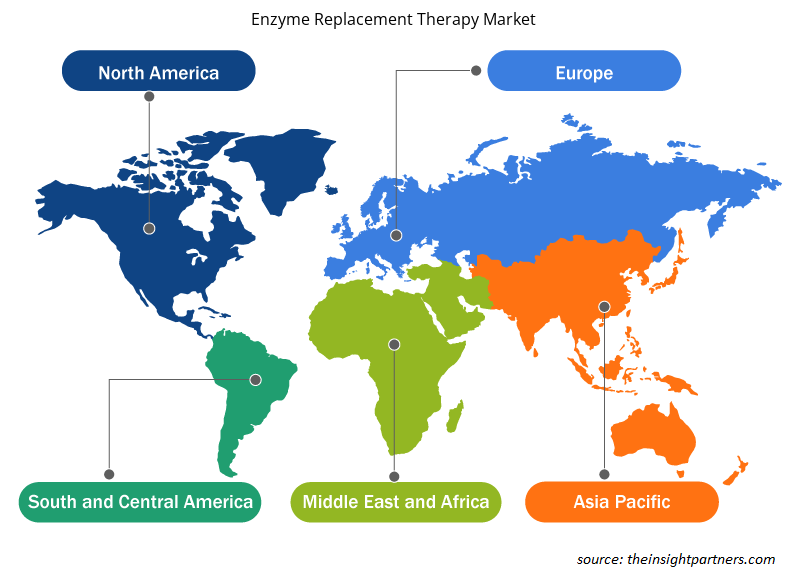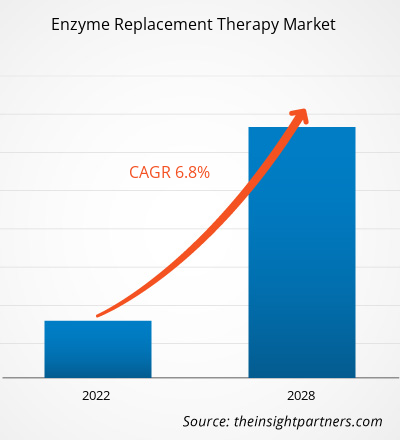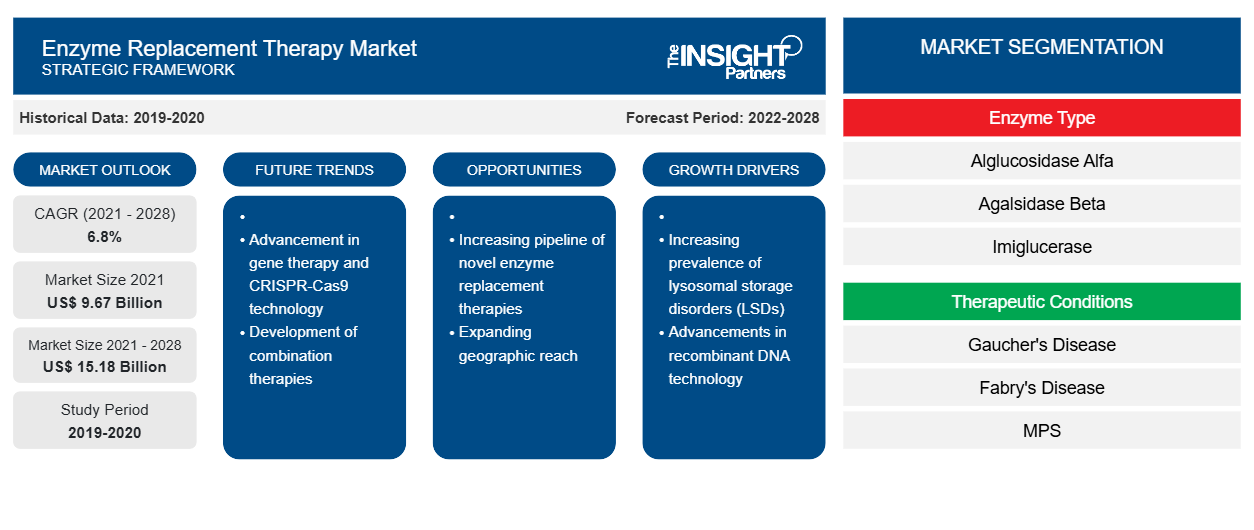من المتوقع أن ينمو سوق العلاج باستبدال الإنزيم من 9،673.39 مليون دولار أمريكي في عام 2021 إلى 15،184.70 مليون دولار أمريكي بحلول عام 2028؛ ومن المتوقع أن ينمو بمعدل نمو سنوي مركب قدره 6.8٪ من عام 2022 إلى عام 2028.
يتم إجراء العلاج باستبدال الإنزيم ( ERT ) لعلاج نقص الإنزيمات الخلقي باستخدام إنزيم أو بروتين له نشاط إنزيمي. تعد الإنزيمات المعدلة وراثيًا والحيوانية والبشرية والمعاد تركيبها من المصادر القليلة للإنزيم المطلوب للعلاج. يتم تطبيق العلاج بشكل عام في أمراض التخزين الليزوزومية النادرة، بما في ذلك مرض بومبي ومرض فابري ومرض غوشيه ومرض تاي ساكس ومتلازمة هيرلر. الطريقة الأكثر شيوعًا للعلاج باستبدال الإنزيم هي الحقن الوريدي، حيث يتم إعطاء الإنزيم البديل مباشرة في مجرى الدم من خلال تنقيط السوائل الخاضع للسيطرة. يُعزى نمو سوق العلاج باستبدال الإنزيم العالمي إلى الانتشار المتزايد لأمراض التخزين الليزوزومية ( LSDs ) والموافقة التنظيمية السريعة مع الفوائد التسويقية الأخرى للدواء الذي يحمل تسمية دواء يتيم. ومع ذلك، فإن المنافسة الشديدة بين اللاعبين في السوق تعيق نمو السوق.
يقدم التقرير رؤى وتحليلًا متعمقًا لسوق العلاج باستبدال الإنزيم العالمي، مع التركيز على معايير مختلفة بما في ذلك اتجاهات السوق والتقدم التكنولوجي وديناميكيات السوق وتحليل المشهد التنافسي للاعبين الرائدين في السوق العالمية. كما يتضمن تأثير جائحة كوفيد-19 على السوق في جميع المناطق. بسبب جائحة كوفيد-19، ركزت العديد من السلطات الصحية على الرعاية المتعلقة بالجائحة. علاوة على ذلك، فات العديد من المرضى الذين يحتاجون إلى العلاج باستبدال الإنزيم عمليات التسريب الخاصة بهم في مارس 2020 بسبب عدم كفاية الخدمات الطبية التي تتعامل مع عبء مرضى كوفيد-19. ادعى المرضى الذين يحتاجون إلى العلاج باستبدال الإنزيم أنهم يشعرون بالقلق أثناء دخول المستشفى أو فيما يتعلق بإمدادات الأدوية. كما كشفت الدراسات أن بعض المرضى يعانون من الاكتئاب وزيادة كمية القلق. وبالتالي، تعطلت جلسات العلاج باستبدال الإنزيم المجدولة ( ERT ) أثناء جائحة كوفيد-19 مما أدى إلى تأثير سلبي على السوق.
قم بتخصيص هذا التقرير ليناسب متطلباتك
ستحصل على تخصيص لأي تقرير - مجانًا - بما في ذلك أجزاء من هذا التقرير، أو تحليل على مستوى الدولة، وحزمة بيانات Excel، بالإضافة إلى الاستفادة من العروض والخصومات الرائعة للشركات الناشئة والجامعات
- احصل على أهم اتجاهات السوق الرئيسية لهذا التقرير.ستتضمن هذه العينة المجانية تحليلاً للبيانات، بدءًا من اتجاهات السوق وحتى التقديرات والتوقعات.
رؤى مبنية على الجغرافيا
من حيث الجغرافيا، يتم تقسيم سوق العلاج باستبدال الإنزيم العالمي إلى أمريكا الشمالية (الولايات المتحدة وكندا والمكسيك)، وأوروبا (فرنسا وألمانيا والمملكة المتحدة وإسبانيا وإيطاليا وبقية أوروبا)، وآسيا والمحيط الهادئ (الصين والهند واليابان وأستراليا وكوريا الجنوبية وبقية دول آسيا والمحيط الهادئ ) ، والشرق الأوسط وأفريقيا (المملكة العربية السعودية والإمارات العربية المتحدة وجنوب أفريقيا وبقية دول الشرق الأوسط وأفريقيا )، وأمريكا الجنوبية والوسطى (البرازيل والأرجنتين وبقية دول أمريكا الجنوبية والوسطى).
رؤى السوق
ارتفاع معدل انتشار أمراض التخزين الليزوزومي ( LSDs )
الليزوزوم هو عضو خلوي مرتبط بغشاء يحتوي على إنزيمات هضمية . الليزوزوم هو المحور الخلوي الرئيسي لهدم الجزيئات الكبيرة وإعادة تدويرها وإرسال الإشارات. يؤدي أي خلل في هذه الوظائف إلى تراكم أو تخزين الجزيئات الكبيرة في الليزوزومات، مما يؤدي إلى تلف الخلايا. السبب الرئيسي لأمراض تخزين الليزوزومات ( LSDs ) هو الطفرات في الجينات المسؤولة عن ترميز إنزيم الليزوزوم. بالإضافة إلى ذلك، تتميز أمراض تخزين الليزوزومات بأنها خطأ خلقي في التمثيل الغذائي يؤدي إلى غياب الإنزيم أو نقصه. يعاني الرضع والأطفال بشكل أكثر حدة مقارنة بالبالغين حيث يمكن للأطفال أن يرثوا الجين المعيب من أحد الوالدين أو كليهما. ومع ذلك، منذ العقد الماضي، تغير النمط، وأصبحت أمراض تخزين الليزوزومات أكثر شيوعًا عند البالغين
علاوة على ذلك، فإن اضطرابات تخزين الليزوزومات تشمل ما يقرب من 70 مرضًا، بما في ذلك مرض غوشيه، ومرض نيمان بيك ، ومرض فابري ، ومرض تاي ساكس ، وأمراض عديدات السكاريد المخاطية ( MPS )، ومرض بومبي . هذه الاضطرابات نادرة بشكل فردي، ولكنها مجتمعة منتشرة بشكل كبير وتؤثر على 1 من كل 5000 ولادة حية. أجرت العديد من البلدان مسوحات لفهم نمط الانتشار، وكان الانتشار العام في ارتفاع. على سبيل المثال، نشرت دراسة في مجلة لانسيت ريجونال هيلث بعنوان "انتشار اضطرابات تخزين الليزوزومات في أستراليا من 2009 إلى 2020". كشفت الدراسة عن النتائج التالية:
- إن معدل انتشار هذا المرض بين السكان الأستراليين هو 1.6 مرة (حالة واحدة لكل 4800 ولادة حية)، وهو أعلى من معدل الانتشار المبلغ عنه في عام 1996 (حالة واحدة لكل 7700 ولادة حية).
- كان مرض فابري الأكثر انتشارًا، حيث يمثل 34% من جميع التشخيصات (حتى عام 2020).
- تعتبر عقاقير LSD أكثر شيوعًا في مرحلة البلوغ مقارنة بالطفولة
وبالتالي، فإن الانتشار المتزايد لـ LSD والعلاجات المحدودة لعلاج هذا المرض تدفع نمو سوق العلاج بالاستبدال الإنزيمي العالمي
رؤى تعتمد على نوع الإنزيم
بناءً على نوع الإنزيم، يتم تقسيم سوق العلاج باستبدال الإنزيم العالمي إلى ألجلوكوزيداز ألفا، وأجالسيداز بيتا، وإيميجلوسيريز، وإيدورسولفاس، وجالسولفاز، وفيلاجلوسيريز ألفا، وإنزيمات أخرى. في عام 2021، استحوذ قطاع الإنزيمات الأخرى على أكبر حصة في السوق. ومن المتوقع أن يسجل نفس القطاع أعلى معدل نمو سنوي مركب في السوق من عام 2022 إلى عام 2028.
رؤى مبنية على الحالات العلاجية
بناءً على الظروف العلاجية، يتم تقسيم سوق العلاج ببدائل الإنزيم العالمية إلى مرض غوشيه، ومرض فابري ، ومرض بومبي ، وSCID، وMPS، وغيرها من الحالات العلاجية. احتل قطاع مرض غوشيه أكبر حصة في السوق في عام 2021 ومن المتوقع أن يسجل أعلى معدل نمو سنوي مركب خلال الفترة المتوقعة.
مسار الرؤى القائمة على الإدارة
بناءً على طريق الإدارة، ينقسم سوق العلاج باستبدال الإنزيم العالمي إلى حقن وفموي. احتل قطاع الحقن حصة سوقية أكبر في عام 2021 ومن المتوقع أن يسجل معدل نمو سنوي مركب أعلى خلال الفترة المتوقعة.
رؤى إقليمية حول سوق العلاج ببدائل الإنزيم
لقد قام المحللون في Insight Partners بشرح الاتجاهات والعوامل الإقليمية المؤثرة على سوق العلاج بالاستبدال الإنزيمي طوال فترة التوقعات بشكل شامل. يناقش هذا القسم أيضًا قطاعات سوق العلاج بالاستبدال الإنزيمي والجغرافيا في جميع أنحاء أمريكا الشمالية وأوروبا ومنطقة آسيا والمحيط الهادئ والشرق الأوسط وأفريقيا وأمريكا الجنوبية والوسطى.

- احصل على البيانات الإقليمية المحددة لسوق العلاج ببدائل الإنزيم
نطاق تقرير سوق العلاج بالاستبدال الإنزيمي
| سمة التقرير | تفاصيل |
|---|---|
| حجم السوق في عام 2021 | 9.67 مليار دولار أمريكي |
| حجم السوق بحلول عام 2028 | 15.18 مليار دولار أمريكي |
| معدل النمو السنوي المركب العالمي (2021 - 2028) | 6.8% |
| البيانات التاريخية | 2019-2020 |
| فترة التنبؤ | 2022-2028 |
| القطاعات المغطاة | حسب نوع الإنزيم
|
| المناطق والدول المغطاة | أمريكا الشمالية
|
| قادة السوق وملفات تعريف الشركات الرئيسية |
|
كثافة اللاعبين في سوق العلاج بالبدائل الإنزيمية: فهم تأثيرها على ديناميكيات الأعمال
يشهد سوق العلاج باستبدال الإنزيم نموًا سريعًا، مدفوعًا بالطلب المتزايد من المستخدم النهائي بسبب عوامل مثل تفضيلات المستهلك المتطورة والتقدم التكنولوجي والوعي المتزايد بفوائد المنتج. ومع ارتفاع الطلب، تعمل الشركات على توسيع عروضها والابتكار لتلبية احتياجات المستهلكين والاستفادة من الاتجاهات الناشئة، مما يؤدي إلى زيادة نمو السوق.
تشير كثافة اللاعبين في السوق إلى توزيع الشركات أو المؤسسات العاملة في سوق أو صناعة معينة. وهي تشير إلى عدد المنافسين (اللاعبين في السوق) الموجودين في مساحة سوق معينة نسبة إلى حجمها أو قيمتها السوقية الإجمالية.
الشركات الرئيسية العاملة في سوق العلاج باستبدال الإنزيم هي:
- سانوفي
- شركة بيومارين للصناعات الدوائية
- شركة تاكيدا للأدوية المحدودة
- شركة آبفي
- شركة جانسن للأدوية (شركة جونسون آند جونسون للخدمات المحدودة)
إخلاء المسؤولية : الشركات المذكورة أعلاه ليست مرتبة بأي ترتيب معين.

- احصل على نظرة عامة على أهم اللاعبين الرئيسيين في سوق العلاج بالاستبدال الإنزيمي
رؤى تعتمد على المستخدم النهائي
بناءً على المستخدم النهائي، يتم تقسيم سوق العلاج ببدائل الإنزيم العالمية إلى المستشفيات ومراكز الحقن الوريدي وغيرها. احتل قطاع المستشفيات الحصة الأكبر في السوق في عام 2021. ومع ذلك، من المتوقع أن يسجل قطاع مراكز الحقن الوريدي أعلى معدل نمو سنوي مركب خلال الفترة المتوقعة.
يتبنى اللاعبون في سوق العلاج ببدائل الإنزيم العالمية استراتيجيات عضوية، بما في ذلك إطلاق المنتجات والتوسع فيها، لتوسيع نطاق وجودهم ومحفظة منتجاتهم في جميع أنحاء العالم وتلبية الطلب المتزايد. ومن بين اللاعبين الرئيسيين الذين يساهمون في السوق شركة Takeda Pharmaceutical Company Limited؛ وSanofi SA؛ وAbbVie Inc.؛ وBioMarin Pharmaceutical Inc.؛ وAmicus Therapeutics؛ وAlexion Pharmaceuticals, Inc. (AstraZeneca)؛ وJanssen Pharmaceuticals (Johnson & Johnson Services, Inc.)؛ وRecordati SpA؛ وPfizer Inc.؛ وCHIESI Farmaceutici SpA
- التحليل التاريخي (سنتان)، سنة الأساس، التوقعات (7 سنوات) مع معدل النمو السنوي المركب
- تحليل PEST و SWOT
- حجم السوق والقيمة / الحجم - عالمي، إقليمي، بلد
- الصناعة والمنافسة
- مجموعة بيانات إكسل
التقارير الحديثة
شهادات العملاء
سبب الشراء
- اتخاذ قرارات مدروسة
- فهم ديناميكيات السوق
- تحليل المنافسة
- رؤى العملاء
- توقعات السوق
- تخفيف المخاطر
- التخطيط الاستراتيجي
- مبررات الاستثمار
- تحديد الأسواق الناشئة
- تحسين استراتيجيات التسويق
- تعزيز الكفاءة التشغيلية
- مواكبة التوجهات التنظيمية





















 احصل على عينة مجانية ل - سوق العلاج بالإنزيم البديل
احصل على عينة مجانية ل - سوق العلاج بالإنزيم البديل